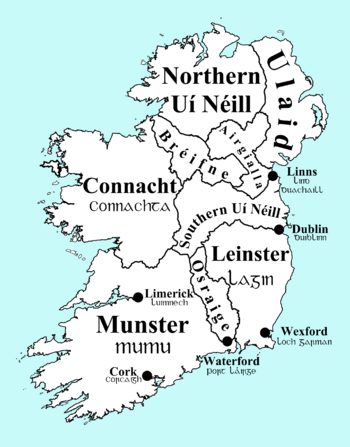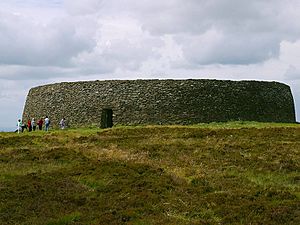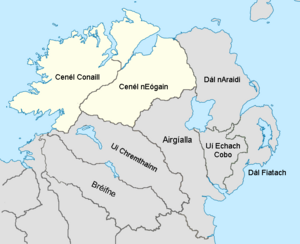Northern Uí Néill facts for kids
Quick facts for kids
Northern Uí Néill
|
|||||||
|---|---|---|---|---|---|---|---|
| Before 425 – 1197 | |||||||

Map of Ireland's over-kingdoms circa 900 AD.
|
|||||||
| Capital | Various | ||||||
| Common languages | Irish | ||||||
| Government | Monarchy | ||||||
| King | |||||||
|
• –465
|
Eógan mac Néill | ||||||
|
• 1196–1197
|
Flaithbheartach Ua Maol Doraidh | ||||||
| History | |||||||
|
• Established
|
Before 425 | ||||||
|
• Disestablished
|
1197 | ||||||
|
|||||||
| Today part of | |||||||
The Northern Uí Néill was a group of powerful families in medieval Ireland. They lived in the north-western part of the country. These families believed they were all related to a famous ancestor named Niall of the Nine Hostages.
Other families in central and eastern Ireland also claimed to be descendants of Niall. They were known as the Southern Uí Néill. Together, all these families formed the larger Uí Néill dynasty.
The main families of the Northern Uí Néill were the Cenél Conaill and Cenél nEógain. They were named after two of Niall's most important sons: Conall and Eógan.
In its early days, the Northern Uí Néill's main kingdom was called In Fochla or In Tuaiscert. Both names mean 'the North'. The Cenél Conaill family first ruled this area. Later, the Cenél nEógain became more powerful. The kingdom then became known as Ailech.
Contents
Mythical Beginnings
Old Irish stories say that around the year 425, three sons of Niall Noígiallach (Niall of the Nine Hostages) invaded north-western Ulster. These sons were Eoghan, Conal Gulban, and Enda. They were joined by Erc, a son of Colla Uais, and his grandchildren.
This invasion greatly reduced the land of the Ulaid people. The land taken by Niall's three sons became the kingdom of Ailech. This land was divided among the brothers. Conal Gulban took the western part, calling it Tír Chonaill. Eoghan took the main peninsula, naming it Inis Eoghain. Enda supposedly took land south of Ailech, which became Magh Enda.
However, there isn't much proof from that time to support these old stories. Historians wonder if this invasion really happened. They also question if the invaders were truly part of the Uí Néill family at all.
Real Origins

Even with doubts about the old stories, historians still call these supposed sons of Niall the Northern Uí Néill.
From the 700s onwards, early Irish historians started writing history in a way that supported the Uí Néill's power. They also promoted the importance of the church in Armagh. This might have involved changing family trees, king lists, and old records. They wanted to make it seem like the Uí Néill had been powerful since the 400s.
Around a dozen groups were eventually included in the "Uí Néill of the North." The Cenél Conaill and Cenél nEógain were the strongest among them.
By the 1200s, the Cenél Conaill family became very powerful in what is now County Donegal. They even created their own history book. It told how Niall Noígiallach's sons came from Connacht and conquered the land from the native Dál Fiatach people. This land roughly matches modern-day County Donegal. Here, they founded their own kingdom and families: the Cenél Conaill and Cenél nEógain.
Recent studies of family lines, place names, and DNA have raised more questions. Some think the Cenél Conaill might be linked to other groups, like the Cruithin. DNA tests of descendants from both Cenél Conaill and Cenél nEógain show a common ancestor from about 1,730 years ago. However, historians like Brian Lacey say this ancestor was likely not Niall Noígiallach.
History of the Northern Uí Néill
The Northern Uí Néill's main kingdom was first known as In Fochla, meaning 'the North'. Its ruler was called rí ind Fhochlai, or 'king of the North'. This kingdom was divided into smaller areas, each with its own local rulers.
The Cenél Conaill's land was called Tír Conaill, meaning 'the land of Conall'. This area later became Tyrconnell and then County Donegal. The Cenél nEógain's land was Inis Eógain, meaning "Eógain's island." This name is still used today for the Inishowen peninsula. Their king was called rí Ailig, the 'king of Ailech'. Their main base was the Grianan of Aileach fort.
The Cenél Conaill were the most powerful family from the 500s to the late 700s. But during the 600s and 700s, they and the Cenél nEógain fought for control. In 734, the Cenél Conaill king, Flaithbertach mac Loingsech, gave up his throne. This happened after a challenge from Áed Allán, the Cenél nEógain king. After this, the Cenél Conaill's power began to fade. Their rulers never again became the main kings of the Uí Néill.
The Cenél Conaill's power collapsed around the 780s. This allowed the Cenél nEógain to gain more land. In 788, the Cenél nEógain burned the monastery of Derry. This monastery had been built by the Cenél Conaill. The next year, in 789, the Cenél nEógain, led by Áed Oirdnide, fought the Cenél Conaill at the battle of Cloítech. The Cenél nEógain won, taking full control of the Northern Uí Néill. They also took the valuable plains of Mag nÍtha. After this battle, the Northern Uí Néill kingdom became known as "Ailech." The Cenél Conaill were then limited to their own area of Tír Conaill.
Conquering Airgialla
At first, the Northern Uí Néill were careful not to challenge stronger kingdoms like Airgialla and Ulaid. However, over the next few centuries, they conquered most of Ulster. This expansion was slow, sometimes less than 10 miles per century.
The Cenél nEógain gained the most from this expansion. They took land from the Airgialla kingdom in central Ulster and the Ulaid further east. The Cenél nEógain moved from their base in the Inishowen peninsula. They crossed the River Foyle into what are now Londonderry and Tyrone. The name Tyrone comes from the Cenél nEógain: Tír nEógain, meaning "land of Eógan."
Airgialla was a group of nine smaller kingdoms. Its name means 'hostage-givers', showing they were under someone else's control. Some think this is why Niall Noigiallach was called 'Niall of the Nine Hostages'.
Airgialla was originally controlled by the Ulaid. But in 827, Niall Caille, a Cenél nEógain king, defeated the combined forces of Airgialla and Ulaid. After this, Airgialla came under the control of the Northern Uí Néill.
During the 900s, a branch of the Cenél nEógain called the Cenél mBinnig settled near Tulach Óc. This was where the Airgialla kings were crowned. By the 1000s, the Cenél nEógain took control of Tulach Óc. They moved their royal seat there from Ailech. This was probably because the site was important and it weakened their rivals. The first Cenél nEógain king crowned there was Áed Ua Néill. Even after moving, Ailech remained strongly linked to the Cenél nEógain.
The Cenél nEógain's expansion pushed Airgialla's power center into southern Ulster.
The Cenél nEógain conquered many areas, including:
- The Mac Cathmaíl (McCaul) family took Clogher, the capital of western Airgialla.
- The Mac Cana (McCann) family spread into northern County Armagh.
- The Ua Catháin (O'Kane) family conquered Cianacht.
- The Ua Neill (O'Neill) family became powerful west of Lough Neagh. They based themselves at Tullyhogue Fort.
- The Uí Fiachrach Arda Strath kingdom became part of Ailech, though it was still ruled by the Airgiallan Ua Crícháin family. They expanded into Fir Luírg (modern-day County Fermanagh) by the 1100s.
Southwards, the Cenél nEógain also established the kingdom of Cairpre Dromma Cliab in modern-day County Sligo.
Despite these gains, the Cenél nEógain also lost some land. The Ua Dochartaig (O'Doherty) family forced them out of Inishowen. The Ua Domnaill (O'Donnell) family expelled the Ua Gairmledaig (O'Gormley) family from Mag nÍtha. Eventually, Fir Luirg and Tuatha Ratha came under the control of the Mag Uidhir (Maguire) family in Fir Manach. Cairpre Dromma Cliab was also lost, conquered by Tigernán Ua Ruairc of the kingdom of Bréifne.
As the Cenél nEógain expanded, the church of Armagh came under their influence. The church of Armagh claimed to be the most important church in Ireland. It continued to create writings that helped promote the Cenél nEógain's claims to power.
The Vikings
During the 800s, the coast of Ailech and the rest of Ulster faced Viking raids. But in the 850s, the Viking groups started fighting among themselves. This allowed the Ulster kings to fight back and win big victories against them.
In 866, Áed Finnliath, the king of Ailech, cleared the Vikings from their strongholds in "the North." He won a battle in Lough Foyle. This was a very important victory. After this, the Vikings mostly left Ulster alone for many years. They left less of an impact on Ulster compared to other parts of Ireland. By the time the Normans arrived in Ulster in the late 1100s, the Vikings' only notable settlement was "Ulfrek's ford" (modern-day Larne).
Grianán of Ailech
Historians believe the Cenél nEógain took over the Grianán fort. This fort might have been in Cenél Conaill territory. When the Cenél nEógain became the new rulers, they renamed it after their home area, giving it its current name, Grianán of Ailech. It is often thought of as the capital of the Cenél nEógain from the 500s. It was destroyed in 1101 by Muirchertach Ua Briain, the king of Munster.
Cenél Conaill
Branches, clans, and septs
Important families and groups of the Cenél Conaill include the O'Donnells, O'Dohertys, O'Boyles and O'Gallaghers. The most famous person from the Cenél Conaill is Saint Columba. He founded the monastery at Derry. He is said to be the grandson of Conall Gulban.
Cenél nEógain
Branches, clans, and septs
Key families and groups of the Cenél nEógain include the O'Neills and MacLaughlins. However, the MacLaughlins were defeated by the O'Neills in 1241. This led to the O'Neills becoming the dominant family among the Cenél nEógain.
See also
- Kings of Ailech
- Irish kings
- Irish royal families
- Airgíalla
- Ulaid
Images for kids



